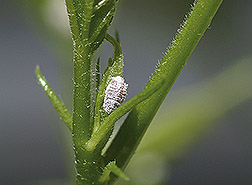
Mealybugs are insects in the family Pseudococcidae, unarmored scale insects found in moist, warm habitats. Of the more than 2000 described species, many are considered pests as they feed on plant juices of greenhouse plants, house plants and subtropical trees and also act as a vector for several plant diseases. Some ants live in symbiotic relationships with them, protecting them from predators and feeding off the honeydew which they excrete.

Scale insects are small insects of the order Hemiptera, suborder Sternorrhyncha. Of dramatically variable appearance and extreme sexual dimorphism, they comprise the infraorder Coccomorpha which is considered a more convenient grouping than the superfamily Coccoidea due to taxonomic uncertainties. Adult females typically have soft bodies and no limbs, and are concealed underneath domed scales, extruding quantities of wax for protection. Some species are hermaphroditic, with a combined ovotestis instead of separate ovaries and testes. Males, in the species where they occur, have legs and sometimes wings, and resemble small flies. Scale insects are herbivores, piercing plant tissues with their mouthparts and remaining in one place, feeding on sap. The excess fluid they imbibe is secreted as honeydew on which sooty mold tends to grow. The insects often have a mutualistic relationship with ants, which feed on the honeydew and protect them from predators. There are about 8,000 described species.

The surfbird is a small stocky wader in the family Scolopacidae. It was once considered to be allied to the turnstones, and placed in the monotypic genus Aphriza, but is now placed in the genus Calidris.

The mottled owl is a medium-sized owl found in Central and South America from Mexico to Brazil and Argentina. The head and back are mottled brown and the underparts whitish, with vertical bars on the chest and throat. The eyes are dark and the head is round and they do not have ear tufts. They are territorial and found in dry forests and jungles at altitudes of up to 2,500 m (8,200 ft) above sea level.

Maconellicoccus hirsutus, is a pest of many plants, trees, and shrubs. It infests hibiscus, citrus, coffee, sugar cane, annonas, plums, guava, mango, okra, sorrel, teak, mora, pigeon pea, peanut, grapevine, maize, asparagus, chrysanthemum, beans, cotton, soybean, cocoa, and many other plants. The pest forms colonies on the host plant, and if left undisturbed, the colonies will grow into large masses of white waxy coverings on branches, fruiting structures, leaves, and even whole plants, including large trees.

Cernuella virgata, also known as Helicella virgata, common name, the "vineyard snail", is a species of small, air-breathing land snail, a pulmonate gastropod mollusc in the family Geomitridae.

Cryptolaemus montrouzieri, common name mealybug ladybird or mealybug destroyer, is a species of ladybird beetle native to eastern Australia. The beetle feeds on mealybugs and other scale insects, and is used to control those pests on citrus orchards worldwide.
Putoidae is a family of scale insects commonly known as giant mealybugs or putoids. There is probably a single genus, Puto, containing about sixty species. The genus name Macrocerococcus has also been used but it is now considered to be a synonym of Puto. The genus Puto was formerly classified as a member of the Pseudococcidae; however, it so significantly differed from the rest of the Pseudococcidae that it was accorded its own family Putoidae.
The Mamfe shrew is a species of mammal in the family Soricidae. It was discovered in 1940, and can be found in Nigeria and Cameroon.

Brumoides suturalis, the three-striped lady-beetle, is a species of ladybird described by Johan Christian Fabricius in 1789. It is found in India, Pakistan, Bangladesh, Sri Lanka, Bhutan, Nepal, Indonesia, Philippines and Papua New Guinea.
Nephus sordidus, known generally as the little brown mealybug destroyer or sordid ladybug, is a species of dusky lady beetle in the family Coccinellidae. It is found in North America.

California produces 80% of the world's almonds and 100% of the United States commercial supply. Although almonds are not native to California, a hot, dry Mediterranean climate and developed water infrastructure create favorable conditions for commercial cultivation of the crop. In 2020, there were 1.25 million acres (5,100 km2) devoted to almond farming in California, producing 2.8 billion pounds (1.3 Mt).
Acropyga exsanguis is a species of ant in the subfamily Formicinae. It lives in underground nests in Mexico, Central and South America.
Geococcus coffeae is a species in the mealybug family, Pseudococcidae, commonly known as the coffee root mealybug, or brown scale. It lives underground where it inserts its mouthparts into roots and sucks the sap.

Pseudococcus comstocki, common name Comstock mealybug, is a species of mealybug. The species was first discovered in 1902 in Japan. It is an invasive pest species that feeds on fruit and plants.
Pseudaspidimerus trinotatus, is a species of lady beetle found in India, Sri Lanka and Myanmar.

Scymnus (Pullus) latemaculatus, is a species of lady beetle found in Pakistan, India, Bangladesh, Sri Lanka, Thailand, and Taiwan.

Scymnus (Scymnus) nubilus, is a species of lady beetle found in Pakistan, India, Bangladesh, Sri Lanka, Nepal, Myanmar, China, and Asia Minor.

Scymnus (Pullus) coccivora, is a species of lady beetle found in India, Bangladesh, Sri Lanka, Malaysia, and Pakistan and probably in Thailand, Bermuda, British Virgin Islands, Grenada, Saint Kitts and Nevis, Trinidad and Tobago and Papua New Guinea.
Ferrisia is a genus of mealybugs.
















